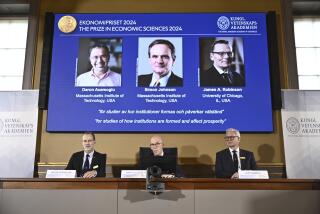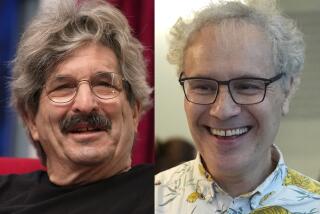A Nobel for Explaining How the Nose Knows
The 2004 Nobel Prize in physiology or medicine was awarded Monday to two American researchers for their discovery of how we recognize individual scents and how those scents can transport us in memory to past times and places.
Dr. Richard Axel of Columbia University and Linda B. Buck of the Fred Hutchinson Cancer Research Center in Seattle shared the award for their joint discovery of a large family of odor receptors in the nose, each of which responds uniquely to a given scent.
Collectively, those responses produce a distinctive, indelible identification in the brain in much the same way that the letters of the alphabet combine to produce unique words.
The sense of smell is one of the most primitive parts of our nervous system, yet it is so powerful that a whiff of a freshly baked madeleine can trigger intense memories of youth, or the remembrance of the foul smell of a bad clam can make one swear off seafood for life.
Congenial scents can enhance the pleasures of fine foods, exquisite wines and even falling in love, while unpleasant ones warn us of dangers, spoiled foods and other experiences best avoided.
But until Axel and Buck published their research in 1991, how the sense of smell operated “was a mystery,” said Sten Grillner of the Nobel Assembly, which selects the recipients of the award. Since the discovery, researchers have been finding that other sensory systems operate in similar fashion.
The pair’s findings are “among the most important studies of the past 50 years, providing insights regarding how individuals perceive their external environment,” said Gerald D. Fischbach, executive vice president of Columbia University Medical Center.
Perhaps the clearest assessment of their impact, said neurobiologist Carla J. Shatz of Harvard Medical School, “is that it is impossible to imagine a course in neuroscience or a textbook of neuroscience that does not incorporate [their] work.”
Both researchers were awakened in the middle of the night to learn of their awards, Buck at home in Seattle and Axel on a visit to San Francisco.
“I’m ecstatic. It’s quite an honor,” Axel, 58, told a radio interviewer who reached him shortly after the award was announced. “Now I am going to get a cup of coffee.”
Buck, 57, proved harder to reach because her telephone number was unlisted. Nobel officials had to rouse a cancer center executive to obtain it.
When an official finally reached her, she said at a news conference Monday morning, she hung up on him because she was fumbling in the dark.
Buck said she hadn’t been thinking about the award, adding, “I was quite surprised.”
The two will share the $1.35-million prize, to be awarded in Stockholm on Dec. 10.
Buck was an immunologist by training who decided she needed to learn how to do molecular biology. To pick up the techniques, she applied for a postdoctoral position in Axel’s laboratory at Columbia. He said she could come only if she worked on neuroscience. Out of that simple encounter was born the first understanding of how smell works.
Many scientists had been looking for the proteins that served as odor receptors in the nose, but with little success.
Using newly developed technology, Axel and Buck decided to look instead for the genes that serve as blueprints for the proteins.
Even then they had little luck until Buck devised what Axel later called “an extremely clever twist,” making three assumptions that would allow them to narrow the search. The first was that the receptor proteins in the nose should look similar to the visual receptor proteins in the rod cells of the eye.
The second assumption was that the receptor protein would have to transmit information to an intermediary known as a G protein, which meant that the gene had to have a characteristic segment of DNA to control that interaction. And finally, Buck assumed that each of the many genes for the individual receptors would be similar.
Those assumptions, Axel said, “saved several years of drudgery” in sorting through thousands of genes.
Ultimately, they found that the mouse genome contained nearly 1,000 genes that code for individual odor receptors. (Humans, less reliant on odor perception, have 350.) The large number of odor genes in the mouse genome -- 1 out of every 100 -- reflected the crucial importance of smell to animals.
Each of the 5 million neurons in the nasal cavity has one of those sensors. When an odor is encountered, the scent molecule may activate anywhere from a handful of different receptors to hundreds of them, producing a unique and characteristic signature that is then transmitted to the brain through small structures, called glomeruli, in the olfactory bulb of the brain.
Using various combinations of 350 nasal receptors, humans are able to recognize 10,000 different scents, and perhaps many times that number.
Since their initial joint publication, Buck and Axel have independently been trying to tease out the mechanism by which the brain stores and retrieves those signals, as well as to understand how they can trigger behavioral responses. That research is still in its infancy, however.
They have also shown that similar systems explain the activity of pheromones -- chemicals secreted by one animal to affect the behavior of others -- and of taste buds in the mouth.
Both researchers’ work was sponsored by the Howard Hughes Medical Institute based in Chevy Chase, Md.






